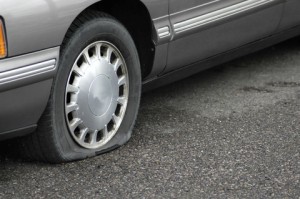 According to the Rubber Manufacturers Association, only one in six vehicles have four properly inflated tires. This means that over 80 percent of vehicles have at least one under-inflated tire, which can incur huge costs to gas and safety if left unattended.
According to the Rubber Manufacturers Association, only one in six vehicles have four properly inflated tires. This means that over 80 percent of vehicles have at least one under-inflated tire, which can incur huge costs to gas and safety if left unattended.
What’s the Big Deal with Under-inflated Tires?
AAA estimates that 1.2 billion gallons of gas are wasted every year because of under-inflated tires. Those same under-inflated tires can cost the typical driver $600 a year in excess gas. It’s easy to argue that if you just watch your tire pressure and top them off every week, you shouldn’t have that problem. However, how many people are actually going to do that, especially when only 15% of drivers know how to check their tire pressure properly? Even if they were to adhere to that schedule, would they be able to do it in a way that actually eliminates that extra cost?
If people aren’t using a tire pressure gauge to check their tire pressure, then how are they doing it (if they are doing it at all)? Well, they could be going by appearance or by the warning light system on their dashboard. However, a tire can be up to 12 pounds low, or 40% low, before it shows any visible signs of being under-inflated. Also, the warning system doesn’t light up until your tires are 25% too low. That kind of under-inflation can cost a lot of money, as well as increase your risk for a car accident. Keep in mind that if your tire needs to be at 35 PSI, even 34 PSI is considered under-inflation and is already wasting gas and putting you at increased risk for a car accident.
Under-inflated Tires are a Huge Safety Problem
So, it’ll cost you in money and gas. Not a big deal if you have a lot of money. However, under-inflated tires are also a safety risk. The biggest safety risk is that driving on those under-inflated tires makes them bend more, increasing their internal heat. The hotter your tires are, the more flexible they become, putting them at increased risk for a blowout if you were to drive over a pothole or take a sharp turn. This increased flexibility also reduces traction, diminishing your vehicle’s handling, making it harder to keep in control in case you need to react quickly or in the case of an accident.
Every month, your tires will lose one to two pounds of pressure, so simply doing the regular maintenance every 3000 miles isn’t enough for tire maintenance and safety. Unfortunately, there’s no way to prevent this from happening.
How Do You Keep Your Tires Properly Inflated?
The best way to keep your tires at their proper tire pressure is with nitrogen tire inflation. Nitrogen tire inflation has been found to maintain proper tire pressure for a longer period of time, which boosts fuel efficiency, tire safety, and tire life. Yes, tire life. The increased wear and tear and increased use of fuel is also hard on your tires, causing them to wear out 50% faster than properly inflated tires (and costing you an extra $150 a year). If interested implementing nitrogen tire inflation into your tire maintenance or managed fleet program, then contact us today.





